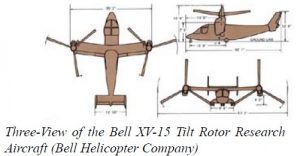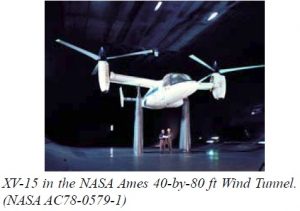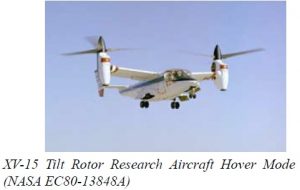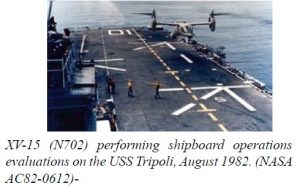by Martin Maisel (photos as credited)
The XV-15
In spite of the failure of the XV-3 to demonstrate the merits of the tilt rotor aircraft, supporters of the concept in the government and industry were convinced that its technical issues would eventually be resolved and it would meet predicted performance targets. To achieve those objectives, the rotorcraft industry (primarily the Boeing Helicopter Company and the Bell Helicopter Company) and government agencies (NASA, the Army and the Air Force) initiated focused research efforts involving design studies, analyses, wind tunnel tests and simulations to improve hover and cruise performance, handling qualities, and flight dynamics and to ensure satisfactory rotor/pylon/wing aeroelastic stability throughout the flight envelope.
 By 1972, high confidence in the new technology garnered the support of top-level Army and NASA management and a joint program was established to develop a new “proof-of-concept” research aircraft. The Army/NASA Tilt Rotor Research Aircraft Project Office was established at the NASA Ames Research Center, Moffett Field, California and the Bell Helicopter Company was selected to build two proof-of-concept XV-15 aircraft. Sadly, Bob Lichten, the leading industry advocate of the tilt rotor died in a motorcycle accident in 1971 and did not live to see the development of the XV-15.
By 1972, high confidence in the new technology garnered the support of top-level Army and NASA management and a joint program was established to develop a new “proof-of-concept” research aircraft. The Army/NASA Tilt Rotor Research Aircraft Project Office was established at the NASA Ames Research Center, Moffett Field, California and the Bell Helicopter Company was selected to build two proof-of-concept XV-15 aircraft. Sadly, Bob Lichten, the leading industry advocate of the tilt rotor died in a motorcycle accident in 1971 and did not live to see the development of the XV-15.

 The XV-15 was powered by a de-rated version of the Lycoming T-53 turboshaft engine modified to allow vertical operation. A significant element of the XV-15 project was the fabrication and bench tests of the new transmission gearboxes and cross-shaft system. Furthermore, the aircraft and its components were subjected to extensive ground tests and a wind tunnel test prior to the initiation of the flight program in 1979.
The XV-15 was powered by a de-rated version of the Lycoming T-53 turboshaft engine modified to allow vertical operation. A significant element of the XV-15 project was the fabrication and bench tests of the new transmission gearboxes and cross-shaft system. Furthermore, the aircraft and its components were subjected to extensive ground tests and a wind tunnel test prior to the initiation of the flight program in 1979.
 By 1981 the flight tests had validated the predicted performance, handling and flying qualities, and aeroelastic stability for all flight conditions. Before long the XV-15 set five new FAI rotorcraft records, including a rotorcraft level flight speed record of 301 knots.
By 1981 the flight tests had validated the predicted performance, handling and flying qualities, and aeroelastic stability for all flight conditions. Before long the XV-15 set five new FAI rotorcraft records, including a rotorcraft level flight speed record of 301 knots.

 When NASA and Army project funding shortfalls threatened the continuation of the flight program, the Navy contributed funds in exchange for an evaluation of tilt rotor operations aboard an aircraft carrier. Government funding limitations also prevented the operation of two aircraft at Ames so one of the XV-15 aircraft (tail number N702) was bailed to Bell to allow them to conduct military and civil operations evaluations and guest pilot flights at Bell’s expense while the NASA/Army team at Ames (using XV-15 N703) conducted research-related flights. The Bell aircraft was also exhibited at the Paris Air Show in 1981 where Senator Barry Goldwater, then the Chairman of the Senate Armed Services Committee, requested a flight in the XV-15. A few months later he became the first non-test pilot to fly the Tilt Rotor Research Aircraft.
When NASA and Army project funding shortfalls threatened the continuation of the flight program, the Navy contributed funds in exchange for an evaluation of tilt rotor operations aboard an aircraft carrier. Government funding limitations also prevented the operation of two aircraft at Ames so one of the XV-15 aircraft (tail number N702) was bailed to Bell to allow them to conduct military and civil operations evaluations and guest pilot flights at Bell’s expense while the NASA/Army team at Ames (using XV-15 N703) conducted research-related flights. The Bell aircraft was also exhibited at the Paris Air Show in 1981 where Senator Barry Goldwater, then the Chairman of the Senate Armed Services Committee, requested a flight in the XV-15. A few months later he became the first non-test pilot to fly the Tilt Rotor Research Aircraft.
 In 1991 a maintenance error caused a rotor control component failure on N702 while the aircraft was in a low hover at Bell. The aircraft rolled over and
In 1991 a maintenance error caused a rotor control component failure on N702 while the aircraft was in a low hover at Bell. The aircraft rolled over and
was destroyed but the two-man crew escaped serious injury. Since NASA and the Army had recently decided to discontinue flight tests of the other XV-15 (N703) at Ames, it was transferred to Bell to allow them to continue their application evaluations and guest-pilot demonstrations.
 By 2002 Bell was involved in other tilt rotor aircraft development programs so XV-15 N703 was flown to the Udvar-Hazy National Air and Space Museum at Dulles, VA, where it was placed on permanent display. The XV-15 was one of the few aircraft delivered to the Udvar-Hazy NASM in flightworthy condition.
By 2002 Bell was involved in other tilt rotor aircraft development programs so XV-15 N703 was flown to the Udvar-Hazy National Air and Space Museum at Dulles, VA, where it was placed on permanent display. The XV-15 was one of the few aircraft delivered to the Udvar-Hazy NASM in flightworthy condition.
By the time the XV-15 was retired, it had accomplished all of its proof-of-concept goals, performed numerous military and civil application evaluations (which involved hundreds of conversions from helicopter-mode to cruise-flight and back to helicopter-mode), experienced two in-flight engine failures followed by
safe landings (demonstrating the effectiveness of the cross-shaft system) and served to introduce over 400 military, civilian, industry and foreign guest pilots to the “new” VTOL technology. As an indication of its contribution to aeronautical technology, in 2003 the National Geographic Society included the XV-15 on its list of the 100 most significant aircraft of the first 100 years of powered flight.
Tilt rotor technology was now in hand – but will it be applied?
Further information about the development and flight tests of the XV-15 is provided in NASA Monograph SP-2000-4517, The History of the XV-15 Tilt Rotor Research Aircraft: From Concept to Flight.
